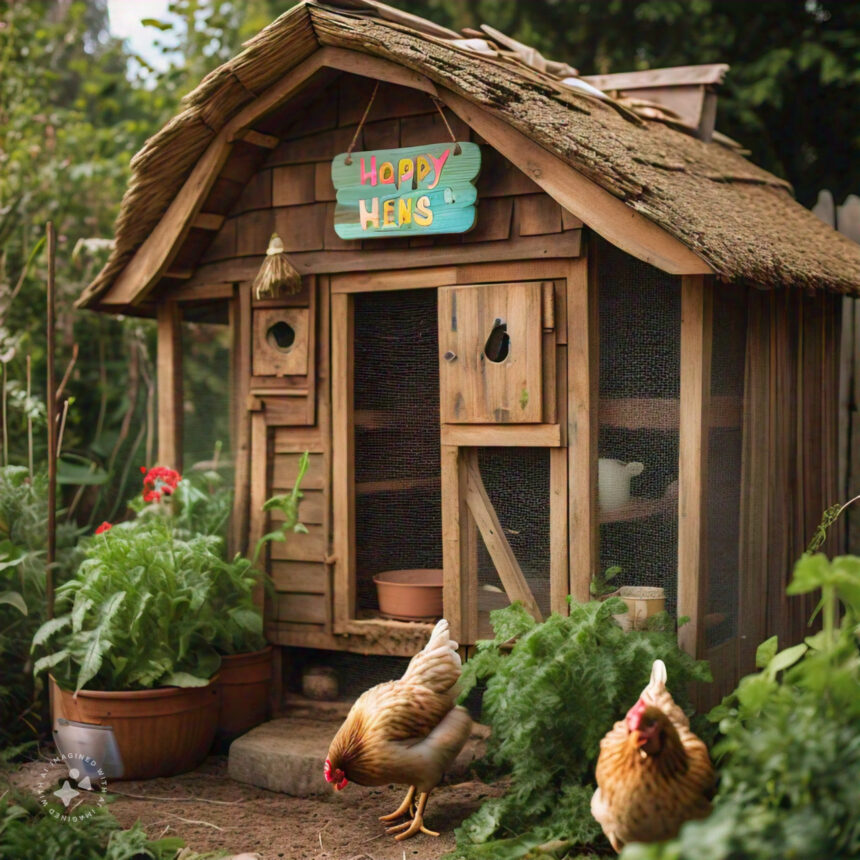Are you ready to start a journey in sustainable urban farming and backyard chicken-keeping?
This guide is your go-to for learning how to make an organic chicken coop for your organic garden. It will give you fresh, free-range eggs, help with natural pest control and improve your permaculture garden. It’s perfect for both new and experienced chicken keepers.
We’ll take you from planning to finishing your chicken coop. You’ll also learn about the best coop size, ventilation, and how to keep predators out, and find out which chicken breeds are best, how to set up a brooder, and what local laws you need to follow.
We’ll also enlighten you on lots of potential organic benefits this setup is likely to bring to your farm.
Planning Your Organic Chicken Coop
Setting up your chicken housing starts with knowing your needs. Think about your chickens’ size and breed, your area’s climate, and your goals for farming.
This helps pick the best design and materials for you and your flock.
Determine Your Needs
First, figure out how big your stock will be. Is it a small group or a big farm? This affects your coop’s size and features.
Also, learn what your chickens need, as some breeds have special requirements.
Choose the Right Plan
There are many free plans and blueprints online to help you.
Look for the perfect design for your flock, yard, and weather.
Consider the number of chickens, features you want, and the weather when picking a plan.
Find Your Materials
For a DIY coop, pick safe building materials. Stay away from pressure-treated wood, which can be harmful to your chickens. Choose tropical hardwood or softwood with a safe sealant instead. Using old pallets or scrap wood can save money and be better for the planet.
Site Selection and Preparation
Finding the perfect spot for your coop is key for your flock’s health and safety.
Look for a spot on high, level ground to keep it dry and safe from floods.
Also, choose a spot that gets plenty of sun but has shade for when it’s too hot.
Choose Your Spot
When picking a spot for your setup, go for something elevated and well-drained. Elevated coops keep moisture away, which is good for your birds’ health.
Make sure it faces south to get lots of sunlight, keeping the coop warm and bright.
Prepare the Area
Before building, get the area ready.
First, remove any plants that are bad for chickens.
Then, fence off gardens, roads, and yards you don’t want your hens in with strong chicken wire.
Get rid of places predators might hide, like woodpiles or big rocks, and trim branches that could be used by hawks or owls.
Choosing the right spot and getting the area ready makes your coop safe, well-ventilated, and healthy. This hard work means your chickens will love their new home.
Constructing Your Organic Chicken Coop
Building a strong and useful chicken coop is key to a thriving organic garden with backyard chickens. Every step in building is important for a cozy, safe, and well-ventilated home for your chickens.
Construct the Coop Frame
The chicken coop framing is the core of the coop. It must be strong and level, ready to hold the coop’s walls, roof, and extra features.
A snaptite assembly system or aviary with tightly-fitting screws and panels can be used.
Also, plan for enough floor space for your chickens, giving each bird at least 10 square feet to move around.
Build Your Run
The chicken run design doesn’t need to be as strong as the coop, but it must be secure and have shade. Make sure the runoff is built well, as fixing mistakes later can be hard. There should be at least 10 square feet of outdoor chicken enclosure to one hen.
Furnish the Inside
Inside the coop, perches and nesting boxes are crucial. Perches should be high and give each hen 8-12 inches of space. Nesting boxes for egg laying should be easy to reach, filled with soft bedding, and placed lower than the perches.
Add the Coop Walls and the Roof
Use materials like wood, plywood, or repurposed pallets for the chicken coop walls, based on your climate and ventilation needs. The weather-resistant chicken coop gable roof can be wood or metal. Adding a removable or hinged wall makes the accessible chicken coop design easier for cleaning and egg collection.
Cut Your Vents
Good chicken coop ventilation is vital for your chicken’s health. Cut vents in opposite walls, just below the ceiling, for air flow all year and also reduce dampness. Add closable vents to cool the coop in summer and not make them susceptible to respiratory issues in chickens away by maintaining good air quality.
Predator Protection and Security
Keeping your chickens safe from predators is the primary reward for successfully constructing a coop.
Using hardware cloth to enclose your chicken run is a smart move. It has smaller holes than chicken wire, making it hard for snakes, skunks, or mice to get in.
Attach the Run Fencing
Put hardware cloth on the bottom three feet of the run fencing and bury it 12 inches deep. This stops burrowing predators. Also, cover the coop floor with hardware cloth to keep out unwanted visitors.
Secure Hardware Cloth and Predator Deterrents
- Use hardware cloth, not chicken wire, to make a safe barrier for your chicken run.
- Bury the hardware cloth 12 inches deep to stop burrowing predators.
- Put hardware cloth on the coop floor for extra safety.
- Use reflective deterrents like tape or CDs around the coop to scare away preys like hawks and owls.
By securing your enclosure, you keep your flock safe from animals that can harm the chickens. This ensures the safety and health of your chickens. A strong coop is essential to successfully raise chickens.
Advantages of Constructing a Coop on Your Organic Farm
Having a coop on your garden offers ecological, economic, and educational advantages for organic farming, making it a versatile and beneficial addition. The benefits include;
Pest Control: The free range poultry may help control pests by eating and deterring unpleasant organisms like insects, larvae, bugs, and other small critters that can damage crops.
Fertilization: The chicken manure is a valuable garden helper that is rich in nutrients like nitrogen, phosphorus, and potassium. Properly composted piles improve vegetable garden soil fertility and structure of the garden plants.
Waste Reduction: Chickens are omnivores so they can help reduce readily available farm waste by eating forage, kitchen scraps, vegetable and residues of lettuce, strawberries and herbs, converting them into valuable manure.
Egg Production: Freshly harvested organic eggs are of different sizes and edible. They are also a great source of healthy protein. They can also be a great way to generate additional income.
Soil Aeration: Chickens at home scratch and peck at the ground. This helps manual aeration of the soil and mix organic matter into it, improving soil health and drainage.
Weed Control: Chickens eat a variety of plants and seeds, to help keep weeds under control naturally without the need for chemical herbicides.
Diversity: Integrating livestock like chickens into your garden enhances biodiversity, promoting a more resilient and balanced ecosystem.
Educational Opportunities: A chicken coop comes with educational opportunities for visitors and children to learn about animal husbandry and sustainable farming practices, on your garden.
Livestock Integration: Chickens can be integrated into your crop rotations and garden management plans, enhancing overall farm productivity and sustainability.
Economic Benefits: Chickens also provide meat, feathers, and other products, contributing to the garden’s economic sustainability.
Conclusion
This guide shows you how to make a safe, useful, and green coop for your backyard chickens. It covers planning, choosing the right spot, building, and also keeping predators away. We have provided all the key information to make the best chicken coop for your organic gardening needs.
It doesn’t matter if you’re new to chickens or have been raising them for years. This guide will show you how to make a safe and cozy home for your birds.
With the right tools, materials, and knowledge, you can turn your backyard into a place that gives you fresh, organic eggs and helps the environment by composting with your chickens.
Raising chickens connects with nature to feel good about feeding your family with food from your own land.
So, take on the challenges, celebrate your wins after you’ve enjoyed making your own chicken coop.





